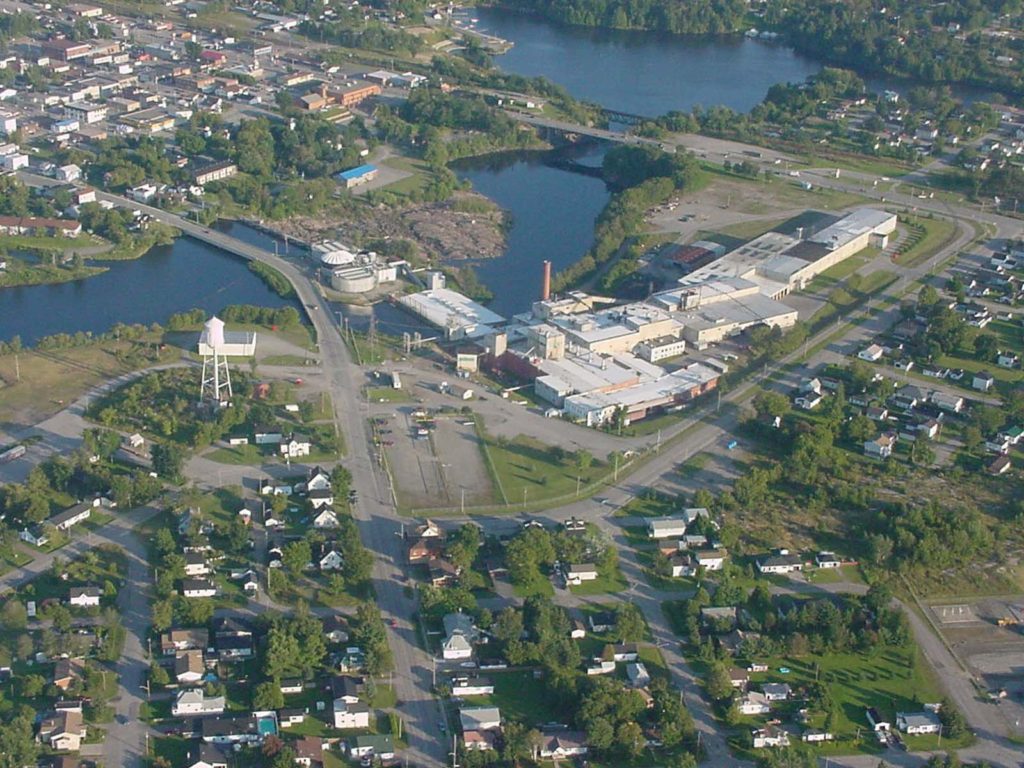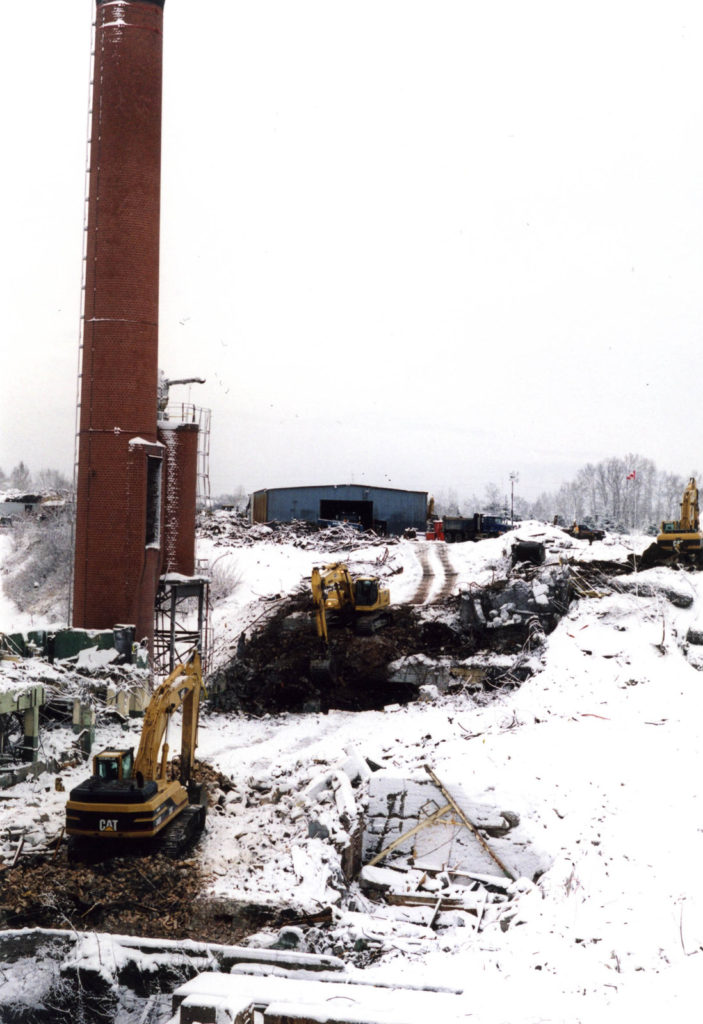Notice of closure of the Sturgeon Falls, Ontario, pulp and paper mill took place on October 8, 2002, two months before the actual mill closure on December 5, 2002. The last day for the unionized women at the offices came six weeks later, on January 16, 2003. The parent company, USA Weyerhaeuser, shredded all of the mill’s history and production records accumulated since the start of the mill 104 years before.

The demolition of the Sturgeon Falls mill began June 1, 2004. Six months later, all that was left was a hole in the ground and the mill’s hydroelectric plant on a property surrounded by a chain-link fence. It was an act of erasure by the corporation that is an integral part of the deindustrialization process and the continued decline of North American’s labour-intensive manufacturing since the late 1960s.

Sturgeon Falls was a single-industry resource town, part of the ‘backbone’ of Canadian staples production – forestry, mining, etc. – throughout the 20th century.
Thunder Bay native Steven High, formerly of Nipissing University, professor of history at the Centre for Oral History and Digital Storytelling (COHDS), Department of History, Concordia University, Montreal, traced Sturgeon Fall’s 1898 beginnings and development in his book, One Job Town – Work, Belonging and Betrayal in Northern Ontario, published in 2018.
Ours was one of the book study circles organized by the Winnipeg chapter with Council of Canadians members from all three Prairie provinces. Over eight weeks, we met via Zoom and discussed two chapters at a time on Tuesdays, one of which featured the author himself, who very generously fielded our questions and comments.
As the author stated in the next-to-last chapter, “Much of the motivation for writing this book originated in my desire to respond to the company’s wanton destruction of working-class memory.” Given that Weyerhaeuser owned the plant for only three years of its 104-year life span, High rightfully asked the question – “Who’s history was it?“
Prof. High recorded the history and pattern of events of this Franco-Ontarian mill town based upon his interviews with the most directly-affected residents – the unionized workers and their families, saying
“I cannot think of a single industrial worker whom I have interviewed in the past twenty years who has not used home and family metaphors to describe attachment to people, place and product…”.
Stephen High
Thus Prof. High’s One Job Town is a people’s history of lives and communities having to weather the impact of corporate decisions in the forestry sector… and beyond. His narration of workers’ reactions who – at a single stroke – saw their jobs, income and identity disappearing before their eyes, strikes home.
After all, with the current Covid pandemic we can all identify with the fear of loss and deep uncertainty regarding the foreseeable future.
The Sturgeon Falls’ history is intertwined with that of the timber industry and the arrival of the Canadian Pacific Railway in 1881. The mine and mill towns of Ontario’s northland were an integral part of the wider colonization project that sought to extend white civilization and industrial modernity northward in a process termed ‘mill colonialism’. As elsewhere in Canada, Indigenous peoples suffered dispossession, were expected to live on the lands reserved to them by treaties, and were relegated to the periphery of any and all ‘development’.
Prof. High applies the term “deindustrialisation” to a central fact of single-industry towns like Sturgeon Falls – their condition of dependence and uncertainty in regard to wood supply, foreign competition, global markets, technological change and environmental concerns. All of which were outside the community’s control but triggered economic change that shaped working-class politics.
The industrial site was owned by a series of large companies: Spanish Pulp and Paper Company (1912-29); Abitibi Pulp and Paper (1929-79); MacMillan Bloedel (1979-99); US Weyerhaeuser (1999-2002).
Strikes and threats of closure were rife throughout the Sturgeon Falls mill’s century of existence. Here’s what Spanish Pulp and Paper Company head Colonel Jones stated during the downturn of 1921:
“Harder times are inevitable… the condition is a worldwide one and employers and employees in the paper trade are not immune from it”.
Where have people heard that before?
A statistic from the union’s own census figures of Local 41 – a tally of directly affected:
253 married union members with children, 56 married without children, 104 unmarried, 5 widowers. Union members had 861 children, an average of 5.4 per member.
Sturgeon Falls did not escape the rigours of the Depression. Closure was most prolonged between 1930 and 1947. During which most of the town lived on poor relief, and Abitibi stripped the mill of two of its three paper machines. It was in this period that many English-speakers – managers and skilled workers – departed. By 1947, the town was predominantly Franco… except for the English-speaking management.
Employment at the mill was a family affair: young men were taken on as students during the summers and many of them followed their uncles and older brothers into the mill for steady jobs and incomes. The unionized mill was the highest-paying employer of town and surrounding-area residents.
The slow decline of the mill that started in the late 1960’s saw one production line after another discontinued, resulting from decisions made in far-off board rooms – corporate restructuring. The rising public awareness of the effects of air and water pollution in the 1970s resulted in stricter government regulations; mills all over the forestry sector could find themselves closed down if they did not demonstrate a measure of compliance.
Herein it is worth mentioning that the indigenous peoples had been witnessing pollution of their streams and decimation of their forests ever since the establishment of pulp, paper and sawmill operations on their traditional lands at the turn of the 20th century.
Even prior to the 1990s, companies like MacMillan Bloedel invested only the bare minimum, just enough to maintain operations. An initiative to convert the mill to an old corrugated cardboard/OCC repulping facility unfolded in 1992. Not even OCC financing from Ontario’s NDP government and a corporate partnership with the West Nispissing Economic Development Committee sufficed to save the mill.
By the late 1990s, mill manager Walter Shisko came to the following conclusion:
“This mill is meaningless in the corporate structure… we are not a core business. Whether we exist or not is of no concern.”
By the time of the final closure December 2, 2002, the mill workers came to realize that their perspectives were not those of the town’s elected officials. Thus, it was anger and a sense of betrayal and abandonment by all parties – including their national union – that dominated mill workers’ reaction to USA Weyerhaeuser’s actions. The mill’s financial records – known to all concerned – posted a profit until the day it closed.
What remains is the mill history binder that had been evolving since 1998 under the loving care of Hubert Gervais and Bruce Colquhoun. It became less a narrative history of the mill and more a yearbook peopled with mill workers and their families. “It’s not just the mill. It’s all of Sturgeon and West Nipissing”.
As author Steven High put it:
“The mill history binder’s very existence is an act of defiance in the face of the erasure that accompanied the mill’s slow decline and final closing. It (the memory book) serves to keep the mill alive in their memories – a sense of place would be impossible without memory.“
We of the book study circle consider One Job Town relevant to today’s reader, hence a valued book of its kind.
Guest contributor: Robert Wilde, Council of Canadians, Edmonton Chapter.